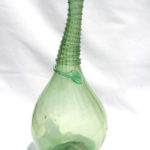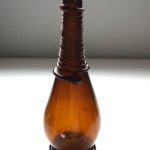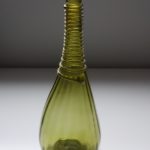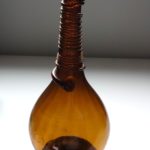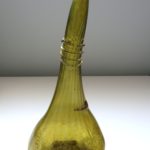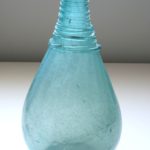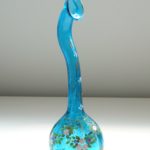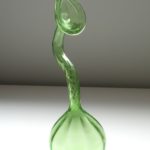1627 – Thomas Herbert
In 1627, Thomas Herbert, an English traveller and historian, stated that “indeed no part of the world has of wine more or better than Sheraz,” and describing Gombroon (Bandar Abbas), referred to “plenty of Shyraz wines brought in long-necked glasses and jars that contain some gallons, the best wine indeed in all Persia.”
ca 1631-1668 – Jean Baptiste Tavernier
Jean Baptiste Tavernier, a French diamond merchant and traveller, is the first authority known to have referred to the making of glass in Persia. He writes “There are in Shiraz three or four glasshouses where quantities of bottles, large and small, are made which serve for the transport of the rosewaters and other scents which are made in this town. They also make a number of diferent sort of containers (vases) for pickled fruits, which are transported to foreign countries.” {note: I’ve been unable to locate this reference anywhere in the original text}
The challenge of working with Tavernier’s Opus, Les Six Voyages de Jean-Baptiste Tavernier, is that Tavernier confounds details from his six trips between 1631 and 1668 at will and ad nauseam – so the details he reports may have taken place at any point during that time period. Tavernier reported on the Persian wine industry thus (my translation from the original French):
It is time to talk about the wines of Persia. In Armenia and neighboring provinces, such as Samegrelo, Georgia, and Media, there are large vineyards. The vines are buried in the winter and uncovered each spring because the country is very cold. In warmer provinces, the vines are grown as they are in Europe, but without using stakes. In Persia, there are three kinds of wines. That from Shiraz, which is the best, is reserved for the King and the great lords; that of Yest is very delicate, and that from Isfahan is poor.
The wine from Yest is transported to Lar where there are many Jews, because these people are careful not to inhabit places where wine is forbidden and where it cannot be procured at a reasonable price. The wine from Yest is also transported to Hormuz, where it sells for half the price of the wine from Shiraz, this is because they wine from Yest is so plentiful. Regarding the wine from Isfahan, it is only made from one grape. This grape is very sweet to the mouth, but it pulls at the throat and warms the throat terribly if one eats too many. This grape is called Kichmichi, it is white and is said to be seedless in the vulgar opinion, but there are seeds that are small and amost imperceptible, which coats the new wine like small filaments. It is said that the wine from Isfahan is cold to the stomach, and that it sends smoke to the head. Regarding the quality of cold, I can say nothing, but I know that it heats the head up well when one drinks too much.
In Persia, the wine is never stored in casks, but rather in large earthenware jars that have been baked in oven. Some of these jars are varnished on the inside, and others are covered in grease from the tails of sheep, because without the varnish or the fat, the earthenware drinks the wine. There are some large jars that hold up to a muis {note: a French term for 1200-liter capacity oak barrels, typically used in the Rhône Valley; also spelled muid}, and others that hold a demi-muis. In the cellars, one can see many of these jars very tidily arranged, and the mouth of each jar (about a foot in diameter) has its wooden lid, as well as a large piece of red canvas that extends from one corner to the other, covering all.
The King and the great lords have other kinds of wine cellars simply to express the magnificence of the wine. They sometimes to go to these cellars with friends and visitors that they choose to regale with drink. These caves are like square rooms, that one goes down into by descending two or three steps. In the middle of the room, there is a small pond filled with water, which is surrounded by a rich carpet purpose-made to cover the floor of the room from the wall to the pond. At each of the four corners of the pond, there are four large glass bottles, each of twenty pints of wine or thereabouts, one of white wine and the other of claret. From each of those big bottles to the next, we see rows of other smaller bottles of the same material and the same shape; that is to say round and with a long neck, each containing about four or five pints, a bottle of white wine following a bottle claret, and so on. Around the walls of the cave, there are many niches in the wall, and in each niche you see a bottle of wine, one a white, the next a claret. There are several niches that were expressly made to hold two bottles. There are several windows that bring daylight into the cellar, and all these rows of bottles of wine so carefully arranged and full of wines of different colours are quite delightful to view. Care is taken to keep them always full. The wine keeps well, and when a bottle is emptied, it is refilled as soon as possible.
In addition, Tavernier tells us some wonderful details about a particular year, 1666, and of the quantities of wine produced, and how it was consumed/exported: Pardon my poor and as yet unrefined English translation of this original french text:
As for wines, those of Shiraz are undoubtedly the best in Persia; but wine is not produced at Shiraz in such large quantities as might be imagined. From all of the great vineyards of Shiraz, plus all that can be collected in the hills four or five leagues around, we have to understand that more than half of the grapes are consumed by: 1) being eaten by those picking the grapes off the vine, 2) in the quantities that are dried, and 3) the large amount that are kept in storage. The Persians are so good at preserving the grapes that, seven or eight months after being picked, they seem as fresh as if they had been gathered eight days earlier. They also consume a large amount of grapes in the manufacture of mulled wine, which is a great help for the poor and travelers, especially the valets who dare to drink wine; as diluting the mulled wine with water, they dip their bread, and it cheers them and gives them strength.
Wine, as all other things, is sold by weight and not by measure. In terms of the weights used in Persia, I have had occasion to speak of these elsewhere in this book. Shah Abbas II enjoying drinking wine, and drank it with both the members of his Great Court and with foreigners. We note that in the year 1666, which is the year in which they manufactured the greatest quantity of wine in many years, the wine-makers made for the Shah’s house fifty thousand mens (the measure of men is that of the men of Keuhne or the old men, which is equal to nine of our pounds of sixteen ounces, and all of the wine is sold at that measure).
The Shah gives permission to produce wine for the four nations of the Franks as well as for his own home. These four nations were the deputies of Trade of the French Company, those of the English Company, those of the Dutch Company, and the Portuguese factor who made his home in Bander-Congo, and sends this wine of Shiraz to all of the Portuguese cities in India, which brings to him and his family a fair profit.
Thus it was granted by the Shah that these four nations would receive between them fifty thousand mens of wine, namely fourteen thousand mens to the French in the hope that we see their vessels arrive, and twelve thousand to each of the other three nations. In doing this, some officers who have the care to deliver grapes, they not only give them are the most beautiful and cheaply, but they allow them to do beyond what he has them been granted, as they did the same with 1666 passes the order of five thousand and mens.
The Jews of Shiraz, who are of the tribe of Levi and are about six hundred families, manufactured between one hundred one hundred and ten thousand mens; because it is the main trade item these poor people produce, including the governor of Shiraz knows they remove part due profit.
In terms of Persian and other Mohammedans; they do not have permission to make wine, and it is a great sin among them even to put their hands. This does not preclude some great lords will forbear to secretly and they buy quantity of grapes because you want to keep eating throughout the year. Here everything is made of Shiraz wine in a year or abundance of grapes was extraordinary, and all that wine has up 200,025 mens, which equals 4,125 barrels of our measure at three hundred pints per barrel. This wine is transported in bottles, and it is carefully packed in crates such that it breaks very rarely.
ca. 1660 – Du Mans
About 1660 {date to be verified}, and speaking primarily of the glasshouses of Isfahan, Du Mans writes:
“The glass-workers, notwithstanding the shortage of wood, are always at work, although not continuously, for they light their furnace when the Pilevers, or gatherers of broken glasses and bottles, have brought them a sufficient quantity; for to found glass – that is to say, fresh glass – here in Isfahan, would not pay them, new glass being made at Shiraz of stones and soda; for there wood is cheaper. Here then they only re-melt that glass, and that with dermene (Artemisia santonica), which is like the heather of our country. They put the glass directly into the furnace, and not into a glass-pot; this fire, which is only half shielded and mixed with flying cinders, causes the glass to become (instead of colourless and clear, as it was) half-black, full of flaws and blebs. Also they make here nothing but bottles, for of that beautiful glass which charms the sight with the lovely hue of a September dew, there is no usage here; nor do these wretches here deserve it. This calling of glass-maker does not presuppose gentle birth, as in France, those here being, like the rest, of the dregs of the population.”
ca 1666-1670 – Jean Chardin
Between 1666-1670, Jean Chardin travelled extensively in Persia, and had the following to say about “the Art of Glass-making” in Persia, one of “those [arts and trades] they do not understand:
“There are Glass Houses all over Persia, but most of the Glass is full of Flaws, and Bladders, and is Greyish, upon the Account doubtless, that the Fire lasts but three or four Days, and that their Derenne, as they call it, which is a sort of a Broom, which they use to make it, doth not bear heat so well as ours. The Glass of Chiras [Shiraz] is the finest in the Country; that if Ispahan [Isfahan], on the contrary, is the sorriest, because it is only Glass melted again; they make it commonly in Spring. They do not understand to Silver their Glass over, as I have observ’d already; therefore their Glass Looking-Glasses, their Sash-Glass, and their Snuff-Bottles are brought to them from Venice. Moreover, the Art of Glass-making was brough to them from Venice, within these four score Years. A Beggarly and Covetous Italian taught it at Chiras, for the Sum of fifty Crowns. Had not I been certainly informed of the Matter, I should have thought they had been beholden to the Portugeuze for their Skill, in so noble and so useful an Art.“
Speaking of Late Persian wine bottles, Chardin was quite specific:
“The bottles in which they transport this wine are of two sizes: the small bottles contain four-and-a-half pints, Paris measure; the large bottles have the capacity of five small ones, being made of thick glass, and wickered on the outside, to make them less subject to breakage. These bottles are stoppered with cotton having melted wax on top, so that they cannot admit air. They are put into cases, ten small bottles in each, with straw, and they are transported in this way throughout the Kingdom, and to the Indies… They also make in Shiraz, for export to the Indies, rose-water, oil, and all sorts of pickled fruits…put in bottles each of which will take two pounds’ weight.”
ca 1647-1673 (likely closer to 1672) – Jean Struys
Between 1647 and 1673, Dutch sailor and sailmaker Jan Struys travelled extensively. It appears he was in Persia between 1668 and 1672, based on a recent book by Kees Boterbloem. In his book, published in 1676, Struys writes:
“On leaving the city [of Shiraz] from the Northwest exit, one enters into a long lane that leads to a garden belonging to the King. The first allée that one sees is all planted with beautiful cypress trees: there are also roses and jasmines that lead one on a pleasant walk to a pond that is better maintained than the rest. Starting in this garden, and for two leagues, you can find nothing but vines that are watered from a river that is formed from several small springs coming out of the nearby mountains. It is from this vineyard and the surrounding hillsides that is made the best wine in Persia, and there is nowhere else that so many dry and liquid jams, of all kinds, are made and of so many types that there are three glassworks in the town that make nothing other than vases and bottles to put them in.” Struys’ Les voyages de Jean Struys, en Moscovie, en Tartarie, en Perse, aux Indes also includes this wonderful visual of Shiraz, presumably with the vineyards depicted in the foreground.
c. 1687 – M. de Thevenot
Writing of Shiraz, de Thevenot says:
There is much glass made there, and several glass-shops are in the town, though they work not constantly in their glass-houses, but let the fire go out after they have employed a certain quantity of materials. They made their glass of a white stone, almost as hard as marble, which they get in a hill four days journey from Schiraz, and it is very clear: especially they make great bottles as clear and delicate as in any other place inthe world; but it is wonderfully strange how they can blwo the great bottles they call Carabas, which are as thick as one’s finger, and hold near thirty quarts of wine; these bottles are covered with the straw of canes.”
In the same passage, he says of the great jars in which the wine is stored:
“But when they broach a jar, it must be presently drawn off, and bottled up in Carabas… in each case or chest they put ten great bottles, with a good deal of straw, and two of these chests make a mules load.”


